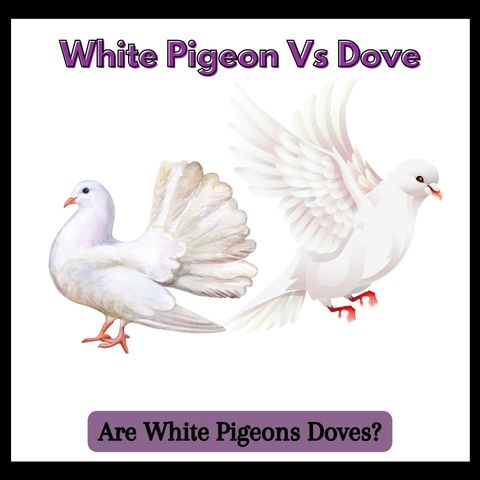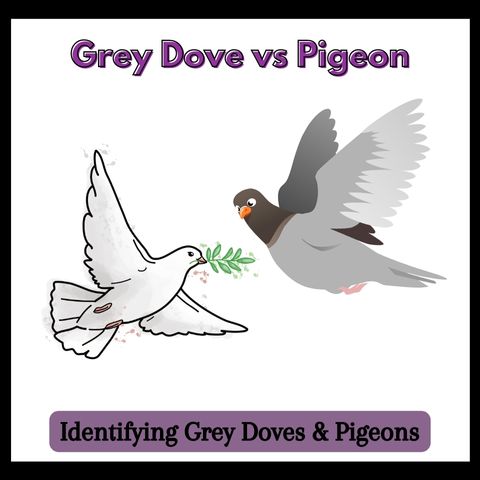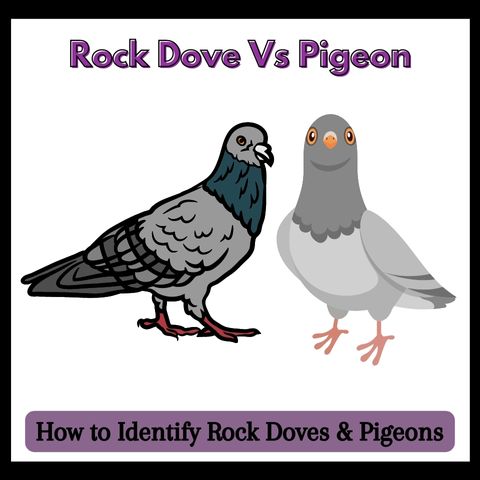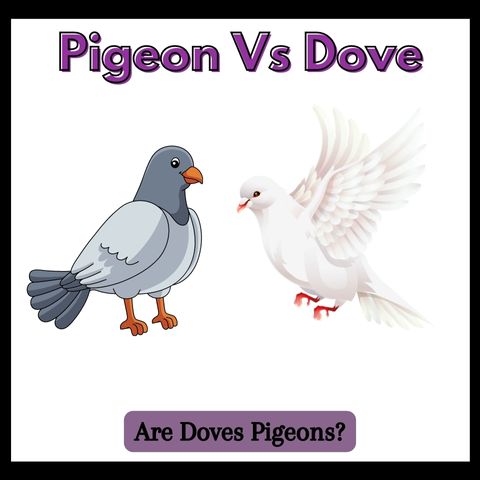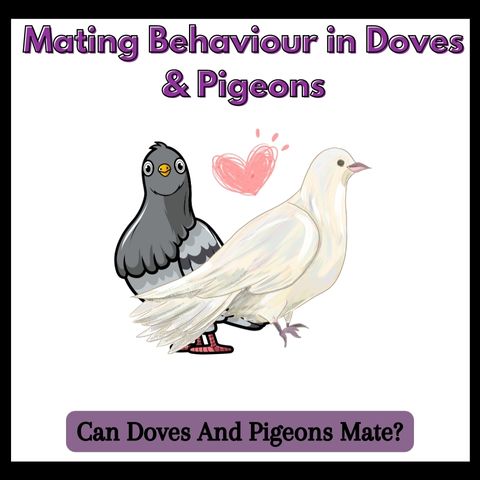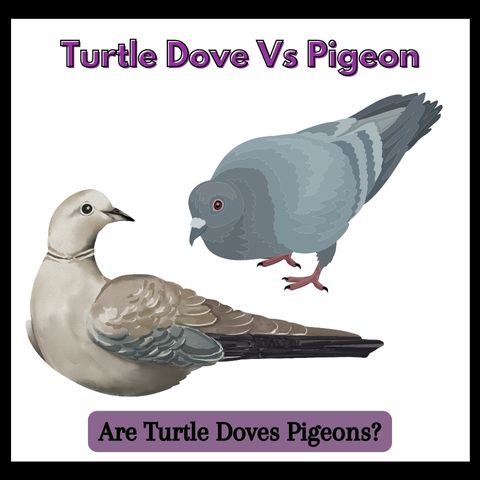Mourning Dove Vs Pigeon: (5 Logical Differences)
If you are wondering ‘Are mourning doves pigeons,’ this article is for you. In this article* I will tell you five major differences between mourning dove vs pigeon that can help you tell them apart. No wonder e fascinating world of mourning dove and pigeon uncover some key differences that keep these two species apart.
Therefore, understanding these differences will help you appreciate the unique characteristics of each species and how they interact with their environment, including humans. But before I tell you how to identify them, let’s first pay attention to learning five major differences between pigeons and mourning doves.
Table of Contents
Are Mourning Doves Pigeons?

No, mourning doves are not pigeons. It is a common misconception that mourning doves are a type of pigeon, but they belong to different groups taxonomically. Although pigeons & mourning doves belong to the same family column bday, they are classified under different genera, with pigeons falling under ‘Columba’ and mourning doves falling under ‘Zenaida macroura.’
Also, there is a huge difference between both species regarding diet preferences, habitat distribution, appearance & size, vocalization patterns, and how they interact with humans. If you want to learn more about this in-depth to confidently tell both species apart, continue reading this article thoroughly. Mourning doves are popular as slender birds with a length of about 9-13 inches and a wingspan of approximately 17-18 inches.
Talking about their habitat & distribution, they are usually spotted in open habitats like Woodland, grasslands, and sometimes in urban areas. Even though mourning doves are considered to be highly adaptable Birds who can thrive in both rural & suburban environments, they are not great at coexisting with us in urban settings compared to pigeons.
Pigeons are said to be very versatile Birds with an impressive ability to type in urban environments. You can find them worldwide near human settlements where human food scraps are abundant. Also, they have a compact & robust build measuring around 11:15 inches in length while possessing a wingspan of 23-29 inches. Also, the plumage of mourning doves is predominantly grey-brown with a distinct black spot on their cheeks, whereas pigeons are known to develop colorful plumage, which may include shades of grey, white, & black.
Mourning Dove vs Pigeon: 5 Key Differences

Mourning Dove vs Pigeon: Physical Appearance
Starting from the basics, you first need to pay attention to the physical appearance of each bird species to identify them. If you pay attention to the appearance of both mourning doves vs. pigeons, you will find some intriguing physical characteristics that can make them easily recognizable. If you talk about mourning doves, they are known for having soft, Grace ground plumage with their slender & elegant appearance.
In addition to this, they are likely to develop black spots on their distinctive features. Conversely, Pigeons will have varied plumage colors, including grey, white, & black. Also, they will look very compact with their robust build, stout body, and broad chest. Talking about the wings, pigeons are known for their rounded wings and fan-shaped tail, whereas mourning doves usually develop long-pointed wings with relatively long-tapered tails.
Mourning Dove vs Pigeon: Habitat & Behavior
You are less likely to spot any mourning dove in an urban setting as they usually prefer to thrive in open areas with access to food & water sources. Also, mourning doves are known as ground feeders who primarily consume seeds & grains. Talking about pigeons, they are highly adaptable to urban environments.
They can easily be spotted in cities and towns, building their nest on buildings, ledges, bridges, and windowsills. As per Pestclue, pigeons are omnivorous feeders who will never mind consuming seeds, grains, insects, and even human food scraps. If you are witnessing a large flock of birds, especially in an urban setting, you are looking at pigeons. Mourning doves are known to forage in pairs or small groups in open areas of rural or wild settings.
Mourning Dove vs Pigeon: Vocalization
Both birds are popular for their unique vocalization; if you identify them through their sound, you can confidently guess the species. If you have ever heard a mourning dove, you might already be familiar with their softer, mournful cooing sound that is very soothing and office associated with tranquillity. Conversely, Pigeons are also cool and cruise, but their vocalization will be more varied, sometimes louder than mourning doves. For more in-depth information on the vocalization differences between mourning doves & pigeons, I will advise you to read my recent article on ‘Pigeon Vs Dove.’
Mourning Dove vs Pigeon: Diet and Feeding Habits
Both species have dietary preferences that vary depending on the availability of food sources & geographic distribution. Since dietary preferences are another distinction between these two bird species, you might want to know how to identify and feed them the right food. As I told you earlier, doves are primarily seed eaters who usually consume grains & seeds from surrounding plants and trees. On the other hand, pigeons are opportunistic feeders with a diverse diet, including seeds, grains, fruits, insects, and human food scraps.
Mourning Dove vs Pigeon: Relationship with Humans
If you focus on learning the social behavior of both birds, you will find mourning doves & pigeons have unique interactions with humans. Mourning doves are generally shy and less likely to approach us closely. Therefore, you should avoid getting near a pair of mourning doves if you spot work as they may feel threatened & stress. Also, mourning doves are popular for their symbol significance in various cultures, often associated with peace & love.
If we talk about the pigeons, they have highly adapted to living closely with us in urban areas. Sometimes, pigeons are also considered pests due to their large populations in certain urban settings. Their droppings undoubtedly contain acids that can erode metal, paint, & cement. Therefore if you want to learn how to prevent this, I will advise you to consider reading my recent article on ‘How To Stop Pigeons Nesting.’
Also, we have shared an in-depth article on removing the pigeon nest if it is causing issues. But before you learn how to get rid of a pigeon nest, you must research: What Happens If You Destroy a Pigeon Nest. There will be some immediate and long-term consequences of pigeon nest removal. But if it is very important, you can consider consulting a professional who can do it for you, like relocating the nest from one place to another.
To know more about how bad their nests can be, read my articles on ‘Why Are Pigeon Nests So Bad.’ Back to the point, pigeons have also been used throughout history as messengers & homing pigeons. Still today, you can witness pigeons performing in races in some parts of the country.
Conclusion
Even though pigeons and mourning doves share some similarities, some key differences keep them set apart. I have given my best to give you all the information on the difference between mourning dove vs. pigeon, which include their distinct appearance behavior, vocalization, food preferences, and their relationship with us, making them unique & valuable components of our natural world.
If you find this article helpful and fun to read, I will advise you to share it. Your share will help many people learn the answer to the question ‘Are mourning doves pigeons’ as well as the difference between mourning doves vs. pigeons so they can also respect & cherish these differences while coexisting harmoniously with these avian inhabitants of our planet.
Next time, if you happen to spot a feral/homing pigeon or a familiar mourning dove, I will advise you to take a moment and admire their beauty & uniqueness. Check my other helpful guide on the relationship differences & similarities between mourning doves and pigeons. See you in the next post, till then, take care & goodbye.

